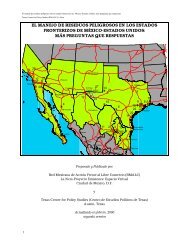Pesticides and Water Quality - Texas Center for Policy Studies
Pesticides and Water Quality - Texas Center for Policy Studies
Pesticides and Water Quality - Texas Center for Policy Studies
Create successful ePaper yourself
Turn your PDF publications into a flip-book with our unique Google optimized e-Paper software.
near Knott, <strong>Texas</strong>. Reports of cattle deaths in the area resulted in studies demonstrating that the deathswere the result of ingestion of arsenic by the cows.Further investigation by TDA concluded that the contamination was the result of historic use of arsenic oncotton <strong>and</strong> poor management practices <strong>for</strong> cotton gin waste. 121 Movement of arsenic pesticides throughuncemented or uncased wells was also identified as one possible source of the problem. One hundredrural water wells were sampled, <strong>and</strong> arsenic was found above the drinking water st<strong>and</strong>ard in 34 wells. 122As a result, many farms in Howard <strong>and</strong> Martin Counties installed their own water treatment systems.Farmers in the area agreed to a temporary prohibition on use of arsenic-based pesticides.A more recent report suggests that the arsenic contamination in Howard <strong>and</strong> Martin Counties should beattributed to “point sources,” e.g., cotton gins <strong>and</strong> gin trash. 123 The report does not, however, explain howthis conclusion was reached. Moreover, the report does not explain the source of the nitratecontamination that was found along with the arsenic contamination in the earlier TDA study. Thus,leaching from the locations of the arsenic applications would still appear to be one of the likely sources.b. Investigation of contamination in Dawson, Comanche, El Paso, Haskell, Hidalgo, Knox, Lynn,Stonewall, <strong>and</strong> Terry Counties: Because of the contamination found in Howard <strong>and</strong> Martin Counties,TDA began a more comprehensive evaluation of potential pesticide contamination of ground water inselected West <strong>Texas</strong> counties. As a result, a number of pesticides <strong>and</strong> fertilizers were identified in theground water in these counties between 1988 <strong>and</strong> 1990. The agency apparently stopped testing in 1990.<strong>Pesticides</strong> confirmed in the ground water were arsenic, atrazine, dicamba, prometon, bromacil, picloram,triclopyr, metolachlor, 2,4,5-T, <strong>and</strong> 2,4-D. 124c. Investigation of contamination at pesticide applicator sites: In the 1980s, a number of studies weredone to evaluate pesticide contamination at aerial <strong>and</strong> ground applicator sites. In one study, about 1000sites were examined. At a number of the sites, ground water was found to be contaminated withpesticides, including ethyl <strong>and</strong> methyl parathion, pydrin, arsenic, 2,4-D, chlorpyrifos, atrazine,cypermethrin, permethrin, trifluralin, molinate <strong>and</strong> DDT. 1252. Testing by <strong>Water</strong> Supply Systemsa. Periodic testing of drinking water: Every supplier of drinking water to the public with 15 or moreconnections has to test periodically <strong>for</strong> contaminants. The frequency <strong>and</strong> number of contaminantsevaluated depends on the size of the system. Of the almost 90 water systems which are monitoring <strong>and</strong>have had detections of pesticides in treated water between 1995 <strong>and</strong> 1997, (§II D), 9 get all or part of theirwater from ground water sources. Ground water-based systems detecting pesticides in finished drinking121 <strong>Texas</strong> Department of Agriculture, Investigation of Arsenic Contamination of Groundwater Occurring Near Knott, <strong>Texas</strong>,(<strong>Texas</strong> Department of Agriculture: Austin, 1988).122 Many of these wells also exceeded the drinking water st<strong>and</strong>ard <strong>for</strong> nitrates, suggesting movement of fertilizers into theground water.123 <strong>Texas</strong> Ground <strong>Water</strong> Protection Committee, Joint Groundwater Monitoring <strong>and</strong> Contamination Report – 1996, SFR-56,(<strong>Texas</strong> Natural Resource Conservation Commission: Austin, 1997), p. 65.124 Rick Piltz <strong>and</strong> Lea Aurelius, "TDA Analyzes Rural <strong>Water</strong> Wells <strong>for</strong> <strong>Pesticides</strong>,”, in Grassroots, (<strong>Texas</strong> Department ofAgriculture: Austin, Spring 1988), p.3.125 See letter report of Engineering Science, Inc. to the <strong>Texas</strong> <strong>Water</strong> Commission dated July 20, 1987 (TCPS files).37




